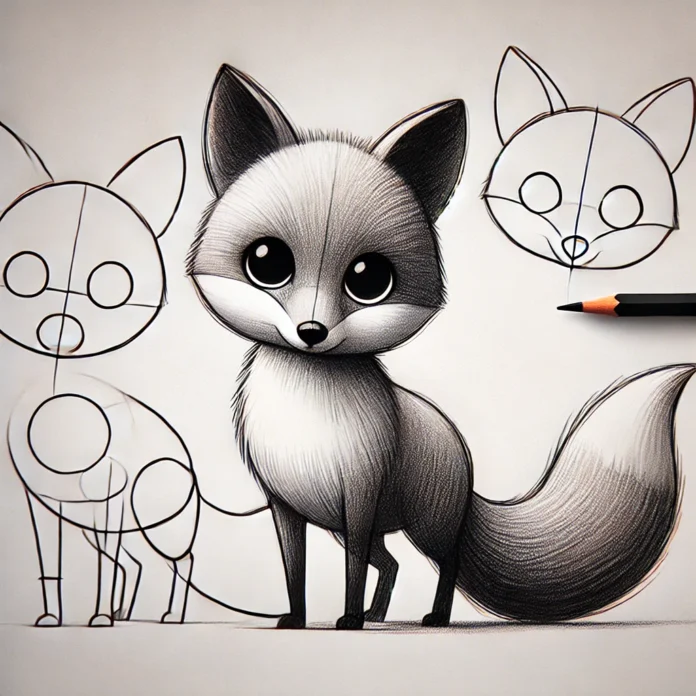Why Drawing:1enzi6g2cvg= Fox is So Popular?
Starting with “drawing:1enzi6g2cvg= fox” has captured interest because foxes are fun, clever, and visually interesting.
But if you’re wondering, How do I draw a fox that doesn’t just look like a dog or cat? – you’re not alone.
This guide, based on “drawing:1enzi6g2cvg= fox,” is here to walk you through the essential tips and tricks, step by step.
Breaking Down Drawing:1enzi6g2cvg= Fox into Simple Shapes
The easiest way to begin “drawing:1enzi6g2cvg= fox” is by visualizing the fox in simple shapes.
Imagine every part of the fox as circles, triangles, or ovals that fit together to form the whole animal.
- Body: Think of it as a rounded oval shape.
- Head: Use a smaller circle or oval for the fox’s head.
- Ears: Draw pointed triangles for the ears.
- Tail: Imagine a long, fluffy teardrop or triangle for the tail.
This structure gives you a base, making the concept of “drawing:1enzi6g2cvg= fox” accessible to all levels of artists.
Details Matter: Eyes, Ears, and Nose in Drawing:1enzi6g2cvg= Fox
Once the structure is sketched out, you can start focusing on the details that make the fox unique.
Adding Fox Ears
Foxes’ ears are distinct, usually tall and triangular, which adds to their curious look.
Draw each ear as a triangle but keep the top slightly rounded for that natural effect.
Capturing the Fox Eyes
Position the eyes slightly outward to give that sly, intelligent look foxes are known for.
They should be small and slightly tilted, making them feel playful and alert.
The Nose and Muzzle
The nose is small and pointed, with a slightly rounded tip, giving it a soft appearance.
This is a key step in capturing the true essence of “drawing:1enzi6g2cvg= fox.”
Example: Imagine tracing these details lightly, gradually building up shading and depth as you go. A gentle hand keeps the drawing from feeling overly controlled, helping your fox feel natural and lively.
Adding Fur and Texture
The next step in “drawing:1enzi6g2cvg= fox” is adding texture to bring the fox’s coat to life.
Here are some quick tips:
- Use short strokes for a soft, furry texture.
- Shade darker areas around the paws, tail, and ears to show their depth.
- Make sure to keep the strokes going in the direction the fur would naturally flow.
Example: Think of each stroke like a gentle brush over the fox’s coat, creating that soft texture foxes are known for.
Getting into Expression: Bring Personality to Drawing:1enzi6g2cvg= Fox
Expression makes your fox stand out. With “drawing:1enzi6g2cvg= fox,” a little personality goes a long way.
Play with the curve of the mouth or the tilt of the eyes to convey emotion, whether it’s curiosity, happiness, or calmness.
How to Make the Expression Pop
- Add a tiny curve to the mouth – a slight upward or downward turn can change the whole feel.
- A small highlight or glint in the eyes adds liveliness.
These tweaks bring life to “drawing:1enzi6g2cvg= fox,” making your fox look more than just a drawing.
Coloring and Shading Techniques in Drawing:1enzi6g2cvg= Fox
Coloring completes your fox drawing, adding vibrancy and realism.
For “drawing:1enzi6g2cvg= fox,” the classic red fox shades or an arctic fox’s whites and grays offer great options.
Classic Red Fox Colors
- Body: Deep orange or red tones.
- Chest and Tail: White or light cream, giving contrast.
- Ears and Legs: Darker browns or blacks.
Arctic Fox Colors
For an arctic fox, stick to soft whites and light grays.
This color palette brings out the colder, softer look of an arctic fox, staying true to their natural appearance.
Tip: Colored pencils or soft pastels can help achieve the blending effects for “drawing:1enzi6g2cvg= fox,” giving your fox that realistic gradient.
Common Questions on Drawing:1enzi6g2cvg= Fox
1. What’s the best way to get started with drawing:1enzi6g2cvg= fox?
Start with the basics: sketching simple shapes to create the fox’s body and head.
Once the base is done, add details like ears, eyes, and nose.
2. What tools do I need for drawing:1enzi6g2cvg= fox?
Use pencils for outlining, colored pencils or soft pastels for shading and adding color.
Experiment with charcoals for a unique, textural effect.
3. Why is my fox not looking realistic?
Focus on soft, short strokes for fur and shading.
And remember, drawing isn’t about perfection – sometimes a bit of roughness adds life.
Tips for Drawing:1enzi6g2cvg=Fox with Ease
- Focus on Shapes: Start with circles, ovals, and triangles.
- Build Details Gradually: Don’t rush the eyes, ears, or fur.
- Add Color Thoughtfully: Reds, browns, and whites bring out the classic fox look.
- Use Light Strokes: It’s okay if it’s not perfect. Foxes are wild, so let your drawing feel free too!
Finishing Touches for Drawing:1enzi6g2cvg=Fox
As you finish up, take a final look over your drawing.
Are the dark and light areas balanced?
Do the eyes and mouth give off the right personality?
Final Tip: Adding a small shadow beneath your fox can give it a realistic grounding on the page, adding to the effect of “drawing:1enzi6g2cvg=fox.”
Final Thoughts on Drawing:1enzi6g2cvg= Fox
Drawing:1enzi6g2cvg= fox is about more than lines on a page; it’s about capturing that clever, curious spirit.
So, pick up those pencils and start your fox drawing – with each stroke, your fox comes to life.
And remember, “drawing:1enzi6g2cvg= fox” can be as fun as it is rewarding – so enjoy every part of the process!
